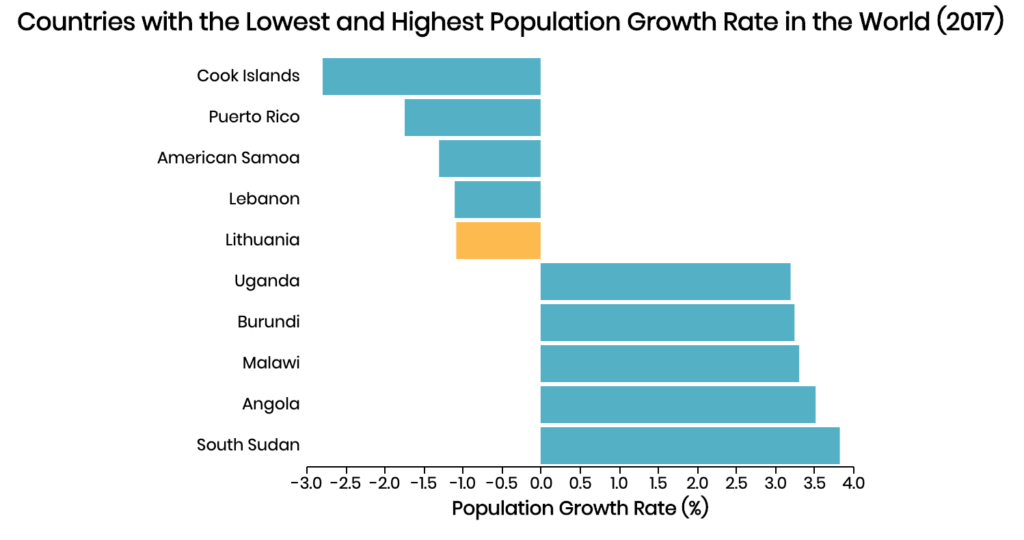The topic of immigration has been in the news a lot these past couple of years. The refugee crisis in Europe, Brexit, the United States’ border wall have all received a fair share of ink. And while some countries are willing to go to extreme lengths to slow down immigration, Lithuania faces the opposite problem. After all, those immigrants have to be coming from somewhere.

For several years now, Lithuania has had the highest rate of population decline in Europe. In 2018 there were almost 14 fewer people for every 1000 residents than in 2017. Neighboring Latvia has also seen significant decrease in its population. In both cases the decline is driven primarily by emigration.

Even when compared to the rest of the world, the three Baltic states land in the bottom ten. In 2017 Lithuania and Latvia shared the 5th place for the lowest population growth rate while Estonia came in 8th. As reported by Bloomberg, the UN predicted that Estonia, Lithuania, and Latvia will lose 13%, 17%, and 22% of their current populations respectively by 2050.

Looking at the past seven decades of the population data, some trends emerge. The peak at 3.7 million occurred in 1991, one year after Lithuania gained its independence from the USSR. Once leaving the country became a possibility, people jumped at the opportunity. Full disclosure, I am one of the data points. I left Lithuania in 2003 to move to the United States after my parents won the green card lottery.
Emigrating became even easier after Lithuania joined the European Union in 2004. Sine 1991 the population has dropped by more than 870,000, which is 24% of the population at its peak. Only 177,000 can be attributed to natural causes (birth/death rate). The rest is due to emigration.
The main reason for this exodus has been economic. The most drastic decline occurred right after the global financial crisis of 2008. That was also the year when Lithuania joined the Schengen Area, which meant that there was no passport control between Lithuania and 25 other European countries. Unemployment rate peaked at 18% in 2010. That year population decreased by more than 65,000. Currently the unemployment rate is around 6%, which is slightly lower than the EU average.
The currency changed from Litas to Euro in 2015, which also resulted in some economic upheaval. More than 66% of Lithuanians who emigrated after 2015 said the main reason was small salaries. While some people move permanently, like my family, a lot of young Lithuanians leave the country with a plan to come back after earning enough money. In 2017 1.1 billion Euros were sent to Lithuania by its citizens living abroad, which made up 2.3% of Lithuania’s GDP that year.

The most popular destination for Lithuanian emigrants has been United Kingdom. In 2018, the number of Lithuanians living in the UK was estimated to be 212,000. Norway and Germany tied for the second place with 48,000 Lithuanian citizens each. Norway has been popular for years because of its extremely high salaries. The net average monthly salary in Norway is 4.6 times higher than in Lithuania.
Brexit has been a big concern for a lot of the Lithuanians living in the UK. Some of those residents will opt to become UK citizens if they can, which means they will lose Lithuanian citizenship. Lithuania is one of the few countries that allow dual citizenship only in very rare cases. For example, having two passports is permitted if a person left or was deported from Lithuania during the Soviet occupation or if a child automatically becomes a citizen of another country at birth.
The ban on dual citizenship made sense in 1990 when the constitution was written. At the time, people feared that allowing dual citizenship would result in hostile countries having voting power. Almost 10% of the citizens in 1989 were ethnic Russians. However, this law is growing more and more unpopular as the border control between European countries becomes a thing of the past. On May 12th there will be a referendum regarding the change to the Constitution to allow dual citizenship. It was scheduled to coincide with the Presidential and European Parliament elections to encourage participation. More than half of the citizens who are eligible to vote need to vote in favor of the proposition in order to make this change.
While emigration continues and the workforce shrinks, there are some positive signs. As reported back in July, Lithuania had one of the fastest growing economies in the OECD (the Organization for Economic Co-operation and Development). Unemployment rate continues to decrease while wages are increasing. Only time will tell if this will be enough to keep young people from trying their luck elsewhere.

Daniel Sandoval
Interesting article. I wonder if those leaving Lithuania are those with higher education levels and if that somewhat gets reflected to the ability of Lithuania to catch up with the rest of the more advanced Western Europe.
Also, how has the sentiment of Lithuanias towards the EU and Russia evolved since they gained their independence?
Christopher Silkworth
bishki shalta